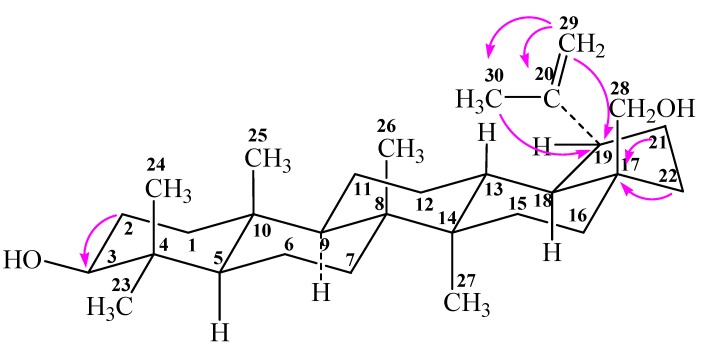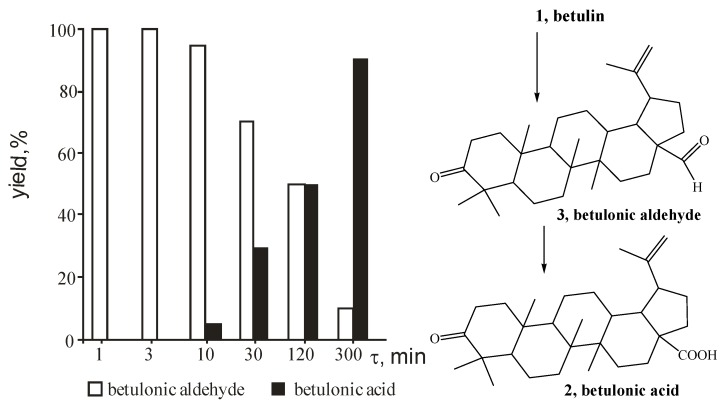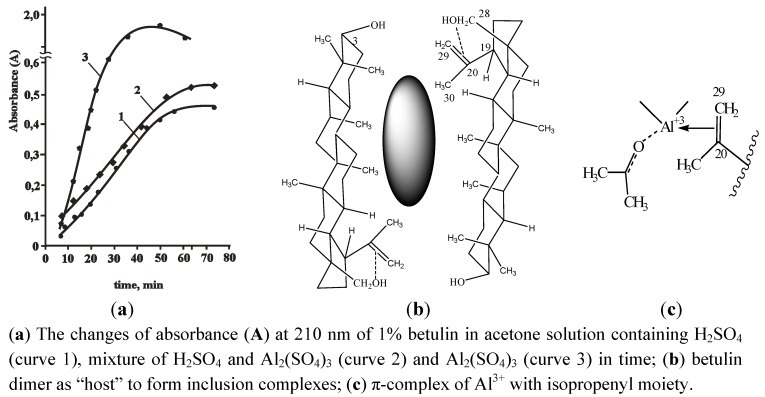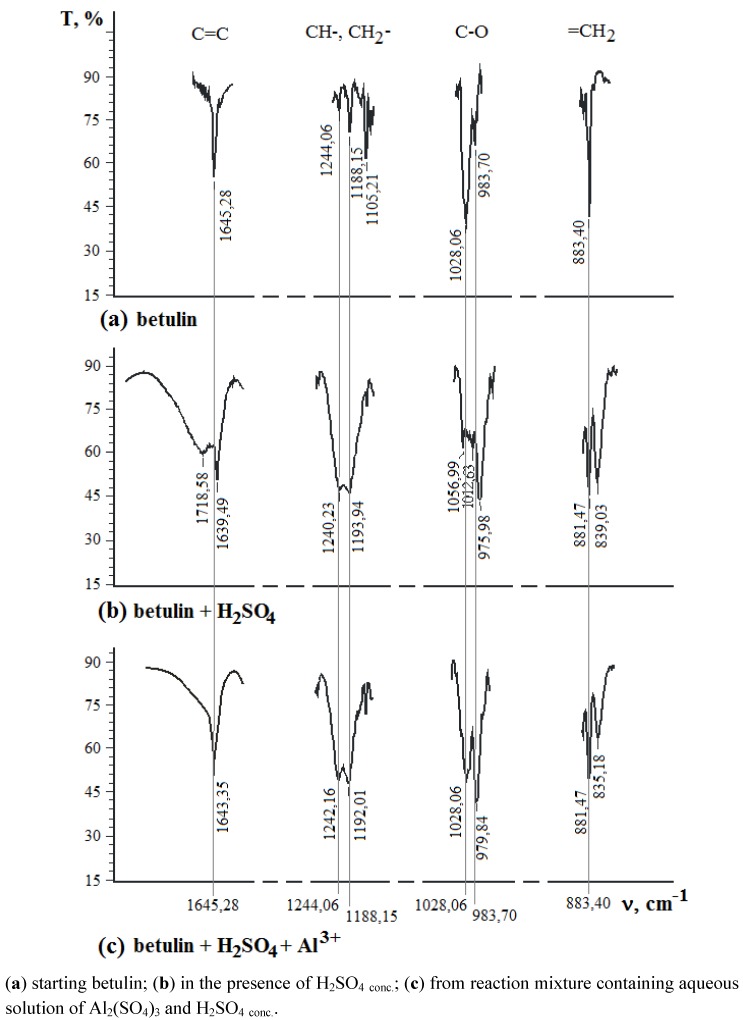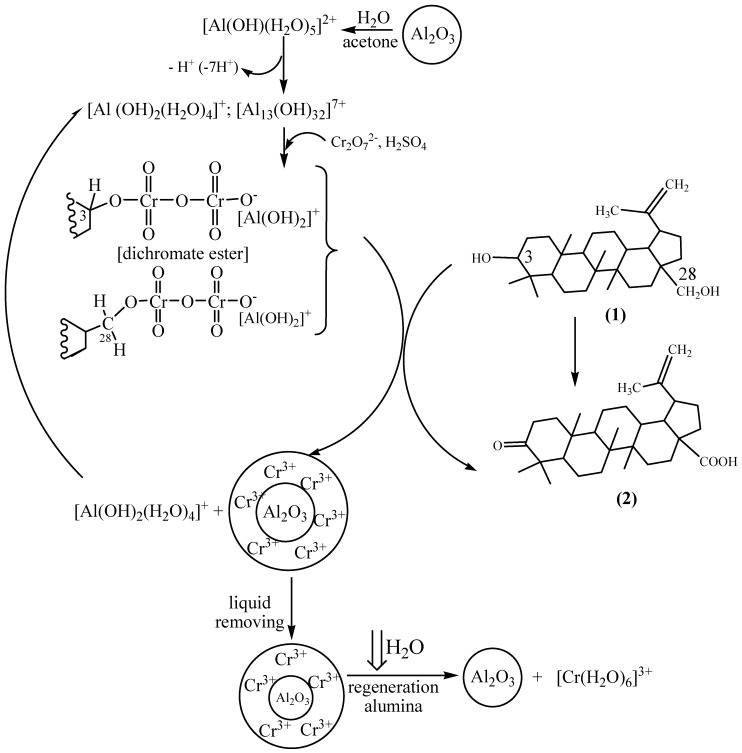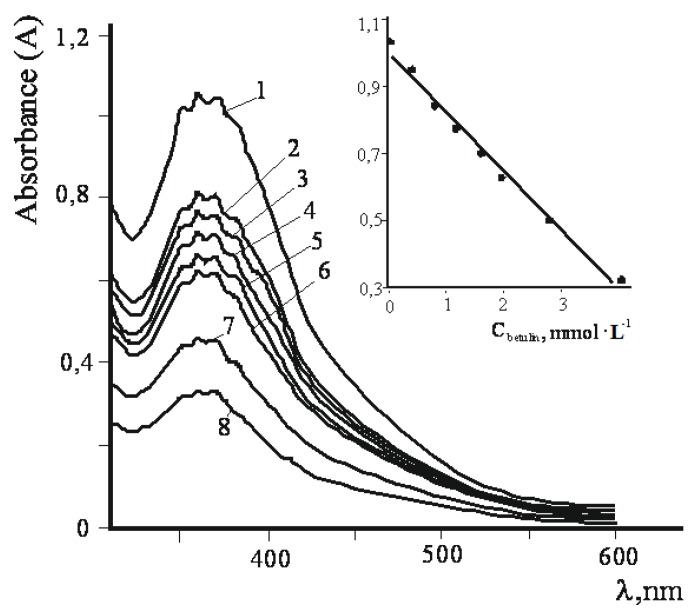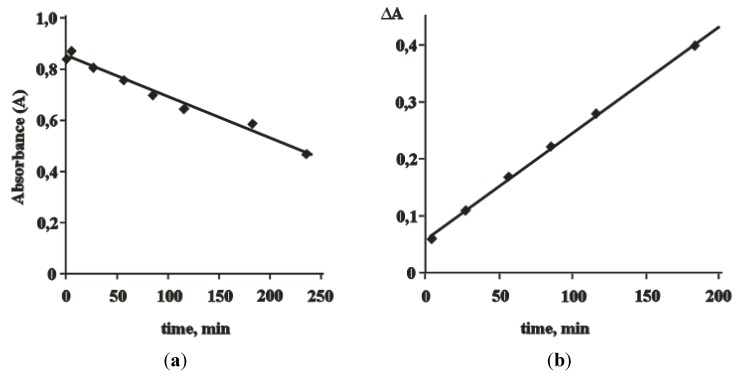Abstract
The room temperature oxidation of betulin by Cr(VI) compounds in aqueous acetone on solid supports such as alumina, zeolites and silica gel has been studied. The oxidation on alumina support leaded to a single product—betulonic acid—in quantitative yield. One hundred percent selective oxidation during 30 min of betulin up to betulonic aldehyde was determined when silica gel support was used. The oxidation of betulin using zeolites as a support gives a mixture of betulonic acid and aldehyde in a 2:1 ratio. It is proposed the selective oxidation up to betulonic acid is due to the influence of Al3+-ions.
Keywords: oxidation on alumina, betulin, betulonic acid, protection of double bond by Al3+-ions
1. Introduction
Betulonic acid [lup-20(29)-en-3-oxo-28-oic] has valuable biological properties such as antiviral, antitumor, anti-inflammatory, antimicrobial, hepatoprotective, as well as immunostimulant activities [1,2,3,4,5].
Until the 2000s interest to betulonic acid was primarily due to its role as the precursor for synthesis of betulinic acid, which is an effective drug against human melanoma. As a rule, betulonic acid was produced using betulin oxidation by Jones’ reagent (CrO3/H2SO4/acetone) or similar synthesis routes with yields less more 75%. This synthesis is long, not very profitable and requires challenging purification steps, including column chromatography, multiple recrystallizations and extraction using very large volumes of solvents, making it unsuitable for extensive scale industrial application [1,2,6,7,8,9,10].
The main problems in the oxidation of betulin are due to, firstly, nonselectivity of the process, because the molecule contains three active centers: primary (at C-28) and secondary (at C-3) alcohol groups and an isopropenyl moiety. Secondly, it is difficult to regulate the range of oxidation because products may be aldehydes or ketones as well as acids. Thirdly, the lability of the betulin structure (Figure 1) provides conditions for different rearrangements as follows on the basis NOESY spectra calculation taking into account of Overhauser effect [11,12].
Figure 1.
Structure of betulin (1).
Taking into account the features of the betulin structure, historically oxidation selectivity was achieved in synthetic routes with protection of the primary alcohol groups of betulin, for example, by acetylation using acetic anhydride [13]. Then betulin diacetate was hydrolyzed up to betulin monoacetate at the C-3 position. The non-protected C-28 alcohol group is oxidized to a carboxyl group by CrO3 in acetic acid and betulinic acid is formed after removing the acetate protective groups.
A number of new chromium (VI)-containing compounds with heterocyclic bases, like pyridinium chlorochromate, pyridinium bromochromate, quinolinium chlorochromate, quinolinium fluoro-chromate, quinolinium bromochromate, imidazolium fluorochromate, pyridinium fluorochromate, imidazolium dichromate and quinolinium dichromate have been developed to improve the selectivity of oxidation of organic compounds [14,15,16].
Quite recently, a two-step route [17] utilizing solid-supported chromium oxide and potassium permanganate has been suggested and even more recently, a TEMPO-mediated electrochemical approach has been devised [7]. Whereas the oxidation of betulin with TEMPO (2,2,6,6-tetramethyl-piperidin-1-oxyl)/NaClO2/NaOCl at 35 °C furnished 92% of the betulinic aldehyde (4), the reaction of betulin with 4-acetamido-TEMPO/NaClO2/NaOCl at 50 °C gave betulinic acid in an 86% isolated yield. Both of these approaches, however, are small-scale preparations and the obtained yields only moderate. The increased selectivity of betulin oxidation was developed only for betulinic acid or betulinic aldehyde production.
Betulin oxidation to betulonic acid must be similar to the oxidation of steroid hydroxyls. Usually the oxidation of steroid or other natural triterpenes having hydroxyl groups at the C-3 position by chromic acid proceeds selectively in the presence of acetone, but the reaction gives double bond oxidation products if acetone is changed for other solvents. The oxidation of primary alcohol groups by chromic acid in acetone medium (Oppenauer’s oxidation) may proceed up to aldehydes or acids like by isopropyl Al-salt catalysis [18]. Concurrent directions of oxidation characteristics didn’t seem reasonable for practical synthesis of betulin derivatives, consequently, development of a practical synthesis of betulonic acid with a mild, selective and high-yielding oxidation in the first stage is a very important problem. Accordingly, several methods have been recently reported for the environmentally benign oxidation of primary and secondary alcohols to carbonyl compounds using solid supports [17,19,20].
Recently the possibility of high selective oxidation of betulin by chromium (VI) compounds immobilized on aluminium oxide or silica gel solid support in donor solvents up to betulonic acid as a precursor of betulinic acid was shown [21]. In this paper we study the protective function of surface aluminum ions as the reason behind the high yields seen in the practical synthesis of betulonic acid from betulin at room temperature in a one-pot reaction by using low cost, easily available potassium dichromate (K2Cr2O7) which may be regenerated as oxidant in the presence of H2SO4 and acetone on a solid support such as alumina.
2. Results and Discussion
It is well known that Lewis acids may catalyze the oxidation of alcohols up to aldehydes [22]. The most catalytic activity was shown by aluminum salts, being also the most selective catalysts. In the first stage of our study the effect of Al3+ on oxidation selectivity and conversion of betulin (1) was demonstrated in experiments by using Al2(SO4)3 in aqueous acetone at room temperature. We obtained betulonic acid (2) as a single product in quantitative yield at a molar ratio νCr6+/ νbetulin equal to 3, and it was easily separated out after 1.5–3.0 h by adding water to the supernatant liquid. The crude betulonic acid didn’t require challenging purification, if it was used for synthesizing betulonic acid derivatives, for example, betulinic acid. The synthesis of betulinic acid by NaBH4 reduction of betulonic acid without challenging purification in isopropanol or THF medium is described in the Experimental section.
In the case when Al2(SO4)3 was absent in the reaction mixture, conversion of betulin was only 40% with the formation of two main products—betulonic acid 2 and betulonic aldehyde 3—and several undetermined products (Table 1). It may be supposed that they were the results of isopropenyl moiety oxidation as estimated by 13C-NMR-spectra [decrease of the signals with δ = 109 ppm (C-29) and δ = 150 ppm (C-20)]; and by IR-spectroscopy [decreasing intensity of bands at 882 cm−1 (methylene terminal double bond) and 1642 cm−1 (double bond)].
Table 1.
Time distribution of selectivity in betulin oxidation without Al2(SO4)3 at molar ratio ν Cr6+/ νbetulin equal to 3 in acetone at room temperature.
| Time, min | Conversion of betulin (1), % | Products in reaction mixture, % (HPLC, IR and NMR-spectra control) | |||
|---|---|---|---|---|---|
| Betulinic aldehyde (4) | Betulonic aldehyde (3) | Betulonic acid (2) | Other unknown products | ||
| 2 | 5 | 15–20 | 55 | – | 20–25 |
| 5 | 7 | 15 | 50–60 | – | 20–25 |
| 10 | 12 | 5 | 60 | 10 | 25 |
| 20 | 17 | – | 60 | 10 | 30 |
| 65 | 25 | – | 50 | 20 | 30 |
| 80 | 30 | – | 40 | 30 | 30 |
| 160 | 37 | – | 35 | 35 | 30 |
| 300 | 40 | – | 20 | 50 | 30 |
| 400 | 50 | – | – | 70 | 30 |
| 150 * | 100 | – | 0–5 | 95–100 | – |
*: The experiment with Al2(SO4)3.
The feature of chromium oxidation in the presence of Al3+, in addition to high selectivity, was the acceleration of the reaction: 100% betulin conversion was achieved in 150 min. This may mean aprotective role of Al3+ as well as a catalytic effect. The disadvantage of this high selective oxidation in the presence of Al2(SO4)3 was the formation of a green coloured inorganic precipitate of Cr2(SO4)3 with toxic properties.
It is a very interesting approach to use a solid support containing Al3+-ions due to the high oxidation selectivity by using Cr3+ sorption on a solid support to minimize sediments. The experiments with aluminosilicate (zeolites) with similar dispersity as a granular solid support were carried out to demonstrate the role of Al2O3 as the best regulator of selective betulin oxidation. SiO2 was chosen as solid support with other acid properties than the Lewis acid—Al3+.
Selectivity of oxidation and conversion of betulin (1) on alumina support in aqueous acetone was due to molar ratio νCr6+/νbetulin, mass ratio msolid support/mbetulin, duration of processes and didn’t depend on the Cr6+-containing compounds (Table 2, examples 3–5). The best selectivity of betulin oxidation up to betulonic acid (2) (100%) with high yield (93%–98%) was obtained under the conditions of experiments 3a–c. The decrease of selectivity in betulin oxidation was shown in experiments with zeolites (Table 2, example 6), since the surface concentration of Al3+ in zeolite is much less than in alumina.
Table 2.
Oxidation of betulin (0.02 mol·L−1) with Cr6+-containing compounds on solid support in aqueous acetone at 15–25 οC during 1.5–3 h.
| Example | Oxidant | Conversion of betulin 1, % | Ratio 2:3 | Selectivity, % | |||
|---|---|---|---|---|---|---|---|
| Cr6+ | Solid support | ν Cr6+ | msolid support/ mbetulin | ||||
| νbetulin | |||||||
| 1 | K2Cr2O7 | Al2(SO4)3 * | 3:1 | – | 100 | 100:1 | 100 (2) |
| 2 | K2Cr2O7 | – | 3:1 | – | 40 | 1:1 | 50 ** |
| 3а | K2Cr2O7 | Al2O3 | 3:1 | 6:1 | 100 | 100:1 | 100 (2) |
| 3b | K2CrO4 | ||||||
| 3c | CrO3 | ||||||
| 4 | K2Cr2O7 | Al2O3 | 1.5:1 | 6:1 | 100 | 3:1 | 75 (2) |
| 5 | K2Cr2O7 | Al2O3 | 1.5:1 | 3:1 | 80 | 1:1 | 50 |
| 6 | K2Cr2O7 | zeolites | 3:1 | 2:1 | 100 | 7:3 | 70 (2) |
| 7 *** | K2Cr2O7 | SiO2 | 3:1 | 10:1 | 100 | 1:100 | 100 (3) |
* CAl2(SO4)3 = 1.6 mmol·L−1; ** selectivity was estimated and the oxidation of isopropenyl moiety wasn’t taken into account; *** synthesis during 30 min.
This result was different in comparison with the experiments carried out without aluminum-ions (Table 2, example 2) or Al2O3-produced ones but under other conditions being equal (Table 2, examples 3–5). The reaction time increased up to 3–5 h (80%–100% betulin conversion), if the molar ratio ν Cr6+/νbetulin was decreased down to 1.5:1 (Table 2, examples 4–5). At the same time the selectivity of betulin oxidation was decreasing (Table 2). The colourless flakes of inorganic nature were formed immediately, and they became green. The flakes adhered to the alumina granules increasing in size, and the supernatant liquid became more homogeneous.
Surprisingly, oxidation of betulin (1) on silica gel for 30 min gave betulonic aldehyde (3) as a single product (Table 2, example 7) with 100% conversion of starting compound. Later on betulonic acid was obtained in the reaction mixture and at 8 hours the molecular ratio of betulonic aldehyde (3) to betulonic acid (2) became 1:1. The betulonic acid formation takes place as betulonic aldehyde oxidation. Assuming that a two-stage mechanism would be realized on alumina support we investigated betulin oxidation under the same conditions but at 0 °C. A two-step mechanism of betulin oxidation on Al2O3 was suggested, but the rate of betulonic acid formation was increased many times (Figure 2).
Figure 2.
Diagram of yields of betulonic acid (black colour) and betulonic aldehyde (white colour) in time.
The data of Table 2 may be explained by the influence of homogeneity in the reaction zone on the selectivity of betulin oxidation in the presence Al3+-ions on solid surface or in the solution. It was been shown that water solution of Al2(SO4)3 as well as H2SO4conc. dissolve betulin (1) in ultra-sound dispersed suspension in acetone giving a transparent colourless solution. The absorbance band in the 190–220 nm region of the UV spectra of aqueous acetone solutions of betulin in the presence of H2SO4 or Al2(SO4)3 mixture was increasing with time up to 70 min and after that it became a constant value (Figure 3a, curves 1,2). The influence of Al2(SO4)3 on betulin dissolution was much more pronounced (Figure 3a, curve 3).
Figure 3.
Betulin dissolving by chelation of components in the reaction medium.
It is common knowledge that selectivity is increased when homogeneity is achieved in the reaction zone [23]. Variation of the dispersion state of the reaction zone on a solid support may be due to the sorption of some components by the solid support, formation of intermediate products and implication of betulin in complexes with Al3+ having better solubility than complexes only with H2SO4.
Such dissolution is typical for inclusion complexes of betulin derivatives with solvents such as benzene, toluene, isopropanol and several metal ions [24], while clathrates are formed by betulin dimers as "head-to-tail" structures. The interaction of H2SO4 with steroid compounds due to their solution and such types of reactions are usually used for identification of steroid rings.
It has been estimated that some red solid products were formed after betulin oxidation by conc. H2SO4 (3 mass %). The IR region (900–800 cm−1) relating to the double bond in the isopropenyl moiety of betulin was changed: one narrow band of 883 cm−1 was transformed into two bands at 881 cm−1 and 832 cm−1 and at the same time, the primary alcohol band (1028 cm−1) disappeared, but the bands of the epoxy group (1242 cm−1 and 976 cm−1) and of allobetulin (1056 cm−1) were established. Changes of the 1740–1640 cm−1 region (C=O, С=С) were noted too (Figure 4).
Figure 4.
IR spectra of solid products evolved from 1% betulin solution in acetone.
We suggest that changes to betulin by the action of H2SO4 occurred upon the oxidation of the isopropenyl moiety as well as the isomerization of the primary alcohol group. The most probable fragments of betulin derivatives are presented in Figure 5. This proposal has been corroborated with 1H-NMR data. The intensity of olefin protons signals in isopropenyl moiety in 1H-NMR spectra (δ = 4.71 ppm and δ = 4.59 ppm) was decreased two-fold. The intensity of signals of C-20 (δ = 150.24 ppm) and C-29 (δ = 109.46 ppm) in the 13C-NMR spectra was decreased too, but δ = 86.79 ppm, δ = 70.33 ppm and δ = 63.52 ppm signals were observed.
In the presence of Al3+-ions (0.01%) the betulin oxidation up to allobetulin or other oxidation products was decreased (Figure 4). Aluminum as an element with a d-configuration with Lewis acid properties that may protect the isopropenyl moiety by formation of a π-complex (Figure 3c) in the presence of H2SO4 as well as Cr6+-H2SO4 system.
Figure 5.
Proposed fragments of oxidation products of the isopropenyl moiety.
The most important advantage of betulin oxidation when Al3+-ions were generated from Al2O3 was the ability to collect Cr3+ compounds as flakes by sorption or by other interactions on the solid surface. This result allows one to remove Cr3+-containing granules from reaction mixtures very easily, in contrast to the SiO2 support which can’t absorb Cr3+.
Aluminium oxide surface layers in aqueous acetone medium are transformed under: (1) surface dissociation, (2) deprotonation and (3) dimerization via hydroxy-bridge joint into different kinds of ions and multinuclear cations respectively [25]:



If such large amounts of sulfuric acid as in our experiments were used, it is most probable that reaction product type (2)—[Al(OH)2(H2O)4]+—ocurrs. The features of high reactivity of wet aluminium oxide surface with [Al(OH)2]+ or [Al(OH)2(H2O)4]+ in aqueous acetone medium containing K2Cr2O7–H2SO4 are due to: (i) anionic species of chromium derivatives with betulin; (ii) formation of inclusion complexes of reduced Cr3+-ions; (iii) solid solution due to replacement of Cr3+–Al2O3 [25,26].
The improved homogeneity in the reaction zone may be explained by stabilization of chromium esters with betulin, formed according to a Westheimer mechanism [27] which is due to aluminium cations (Scheme 1).
Scheme 1.
General formulation of synthesis of betulonic acid using oxidation of betulin on alumina in aqueous acetone by K2Cr2O7–H2SO4.
The oxidation of betulin by K2Cr2O7–H2SO4 in aqueous acetone in the presence of Al3+ was studied in more a detail by UV spectrophotometry. A UV absorption characteristic of Cr6+ in different media occurs at λmax = 350–360 nm. The absorbance (A) at a fixed wavelength follows the Beer-Lambert Law. Dichromate-ion may exist as the following forms: Cr2O72−, HCrO4−, HCr2O7−. Lately HCr2O7− has been considered as the main particle in K2Cr2O7–H2SO4 system [25,26].
The reaction mixtures were at the constant concentration of oxidant (K2Cr2O7–H2SO4) and Al2(SO4)3 but with variable concentration of betulin. From Figure 6, the peak intensity at 360 nm decreased linearly as the concentration of betulin increased.
Figure 6.
UV-visible spectra of reaction mixtures; CK2Cr2O7 = const = 6.05 mmol·L−1; CAl2(SO4)3 = const = 0.27 mmol·L−1. Initial concentration of betulin corresponds to N curves (mmol·L−1) 1–0; 2–0.40; 3–0.80; 4–1.21; 5–1.61; 6–2.01; 7–2.82; 8–4.03. The inset figure is magnification for the absorbance A: A = f (cbetulin).
The decrease of the absorption at λmax = 360 nm means the concentration of Cr6+ is decreasing and may be explained by the interaction of betulin (1) with Cr6+ – H2SO4 – oxidant resulting in formation chromate ester according to the Westheimer mechanism for the oxidation of alcohols [27]. The Westheimer mechanism involves the rapid initial formation of a chromate ester followed by the low rate determining, decomposition of the ester by removal of the α-proton by base B. In aqueous acetone the base was considered to be water. Some reports consider chromium oxidation in acid medium as a process of conversion to the protonated bimetallic chromium (VI) species, resultant in the formation of the monochromate ester which, under the decomposition in the rate-determining step, to give the product [25,27]. Monitoring the absorption at 360 nm in time A = f (τ) in the initial reaction mixtures was studied. The sampling was carried out from supernatant liquid using reaction mixture during synthesis of betulonic acid (2). Dilution of supernatant liquid by CH3CN – DMSO in a volume ratio of 10:1 conserved the homogeneity of the analyzed sample.
The absorbance (A) at 360 nm was decreased 2-fold during 1.5–2 h (Figure 7), while 100% conversion of betulin (1) was achieved during this time. The analysis of the crude from supernatant liquid corresponded only to the betulonic acid (2). This result was due to the participation of only monochromate ester in betulin oxidation although dichromate ester was formed initially.
The value of ΔA depends proportionally on the concentration of Cr6+-containing complexes or ester with betulin. The linearity of absorbance against time plots means that the reaction was found to be of zero order with respect to Cr6+-containing compound mathematically and, most probably, had catalytic character. Actually, it is very difficult to estimate kinetic parameters in such multistage reactions passing through parallel and sequential reactions (ester or complex formation, oxidation).
Figure 7.
Dynamic range of the absorption at 360 nm (a) A = f (τ) during synthesis for supernatant liquid of reaction mixture under condition: Cbetulin = 2.01 mmol·L−1; νCr6+/νbetulin = 3; mbetulin/mAl2(SO4)3 = 10. 20-times dilution of sample was carried out by CH3CN–DMSO in volume ratio as 10:1. (b) ΔA = f (τ), where ΔA = Ain − Acar, Ain – initial absorption; Acar – the absorption in a time of synthesis.
3. Experimental
3.1. General
IR spectra were run from on a Shimadzu IR-Prestige-21 instrument (KBr tablets). The 1H- and 13C-NMR spectra were recorded on a Bruker Advance DPX–200 or a Bruker DRX SF-500 spectrometers in DMSO-d6 solution using TMS as an internal standard. The UV-Vis spectra were obtained on a Analytik Jena Specord S-100 instrument. Melting points were measured using the capillary tube method on an Electrothermal 9200 apparatus. HPLC analysis were done using a Shimadzu LC-10 Avp equipped with a Discovery C18 column (250 × 4.6 mm, 5μm) and UV-detector. The eluent was acetonitrile—water 80:20 (υ/υ) as isocratic mobile phase at a flow rate of 1 mL·min−1 at 25 οC, the injection volume was 20 μL, the detection was accomplished at 210 nm, and the analysis time was 15 min. Residual traces of Al (III) and Cr (VI) were determined by a Shimadzu AA 7000 Atomic Absorption spectrophotometer using standard solutions. Electron-impact mass spectra (EI-MS) were obtained on a JMS-HX 110 mass spectrometer.
3.2. Materials and Reagents
Deionized water (pH 5.6, χ 18mSm) was used, solvents (acetone, isopropanol, methanol) were purified by known methods. As a solid support we used silica gel 60 (15–49, 40–63 and 63–200 μm, Merck), Alumina - γ-Al2O3 (Aldrich), zeolite 13X, NaA (270, 325 and 400 mesh, Merck). “Wet” solid support was formed by impregnation of oxidant (Cr6+-compound–H2SO4).
Betulin (1,C30H50O2) was prepared according to the literature method [28], m.p. 260 °C (lit. 254–256 °C [28]); purity 99.5%, IR, ν, cm−1: 3470 st (OH), 1640 st (C=C); 1H-NMR δ, ppm: 4.67 m (1H, =CH2), 4.57 m (1H, =CH2), 3.78 br. s (1H, 28-CH2OH), 3.31 m (1H, 28-CH2OH), 3.17 m (1H, 3-CHOH), 2.36 m (1H, 19-CH), 1.66 s (3H, CH3), 1.23 s (3H, CH3), 0.96 s (3H, CH3), 0.94 s (3H, CH3), 0.80 s (3H, CH3), 0.74 s (3H, CH3). 13C-NMR, δ, ppm: 76.71 (C-3), 109.46 (C-29), 150.24 (C-20), 57.87 (C-28). EI-MS m/z (%): 442 (M+, 40), 411(60), 203 (95), 189 (100), 95 (85).
3.3. Oxidation of Betulin (1) to Betulonic Acid (2) by K2Cr2O7–H2SO4 on Alumina
Granules of Al2O3 (9.2 g, Asp = 500 m2/g) was treated with potassium dichromate solution (3 g, 10 mmol), H2O (20 mL) and conc. H2SO4 (5 mL) in sequence. Betulin (1, 1.5 g, 3.4 mmol) was dispersed by ultra-sound in acetone (138 mL) to give a white suspension. Oxidant with “wet” alumina was added to the suspension of betulin in a reaction flask, then the reaction mixture was stirred for 1.5 h (HPLC-control). After the residue of inorganic compounds was removed, water (500 mL) was added to the liquid phase. Crude betulonic acid (2) precipitated (as white flakes) and after filtration 2 was washed multiple times with hot water. The precipitate (1.48 g, 97% yield) was recrystallized from methanol. The crystals were isolated and dried in a vacuum oven to afford pure (>95% by HPLC) 2, m.p. 250–52 °C (methanol) (lit. 245–248 °C [6]). IR, ν, cm−1: 1705 st (C=O), 1641 st (С=С); 883 st (=CH2); 1Н-NMR δ, ppm: 4.68 s (1H, 29-H), 4.55 s (1H, 29-H), 2.23 m (1H, 19-H), 1.65 s (3H, 30-CH3), 1.02–1.95 (3H, complex, CH2, CH), 1.02 s (3H, 26-CH3), 1.00 s (3H, 25-CH3), 0.98 s (3H, 27-CH3), 0.86 s (3H, 23-CH3), 0.85 s (3H, 24-CH3). 13C-NMR δ, ppm: 216.52 (C-3), 109.67 (C-29), 150.33 (C-20), 177.26 (C-28). EI-MS m/z (%): 454 (M+, 58), 248 (64), 219 (42), 205(76), 189 (88), 136 (100), 121 (90). The precipitate of betulonic acid after recrystallisation (methanol) didn’t include any residual traces of Cr and Al.
3.4. Oxidation of Betulin by K2Cr2O7–H2SO4 on Silica Gel
Granules of SiO2 (10 g, Asp = 800 m2/g) were treated with potassium dichromate solution (1.5 g, 5 mmol), H2O (40 mL) and conc. H2SO4 (2.5 mL) in sequence. Betulin (1, 1 g, 2.3 mmol) was dispersed by ultra-sound in acetone (40 mL) to give a white suspension. Oxidant with “wet” SiO2 was added to suspension of betulin in a reaction flask, then the reaction mixture was stirred during 10 min (HPLC-control). After that the SiO2 was removed and water (500 mL) was added to the liquid phase. The white flake precipitate was filtered, washed with hot water and was dried. The finished product was identified as betulonic aldehyde (3), m.p. 163–165 °C (lit. 165–166 °C [29]). IR, ν, cm−1: 1730–1728 st (C=O), 1641 st (С=С); 883 st (=CH2); 1Н-NMR δ, ppm: 9.67 s (1Н, 28-СНО), 4.68 s (1H, 29-H), 4.55 s (1H, 29-H), 2.99 dd (1H, 3α-H), 2.23 m (1H, 19-H), 1.65 s (3H, 30-CH3), 1.02–1.95 (3H, complex, CH2, CH), 1.02 s (3H, 26-CH3), 1.00 s (3H, 25-CH3), 0.98 s (3H, 27-CH3), 0.86 s (3H, с, 23-CH3), 0.85 s (3H, с, 24-CH3); 13C-NMR δ, ppm: 216.52 (C-3), 109.67 (C-29), 150.33 (C-20), 206.55 (C-28). EI-MS m/z (%): 438 (11.5), [M-CHO]+ 409 (20.0), 273 (3.2), 219 (20.2), 205 (38.4), 189 (39.6), 133 (35.6), 105 (55.8), 81 (65), 55 (100).
3.5. Synthesis of Betulinic acid Using Crude Betulonic Acid (2)
The crude betulonic acid (2) was subjected to NaBH4 (THF or isopropanol) reduction (10 molar ratio to betulonic acid) at room temperature to yield a mixture (5:95) of 3α- and 3β-betulinic acid (1.4 g), m.p. 295–300 οC (methanol), after recrystallization m.p. 310–311 °C (lit. 290–293 °C [30]). IR, ν, cm−1: 3450 st (OH), 1683 st (C=O), 1641 st (С=С); 883 st (=CH2); 1031, 1042 st (α, β-3-C–OH). 1Н-NMR δ, ppm: 4.68 s (1H, 29-H), 4.55 s (1H, 29-H), 3.24 t (1 H, 3β-H), 2.99 dd (1H, 3α-H), 2.23 m (1H, 19-H), 1.65 s (3H, 30-CH3), 1.02–1.95 (3H, complex, CH2, CH), 1.02 s (3H, 26-CH3), 1.00 s (3H, 25-CH3), 0.98 s (3H, 27-CH3), 0.86 s (3H, 23-CH3), 0.85 s (3H, 24-CH3). 13C-NMR δ, ppm: 76.83 (C-3), 109.67 (C-29), 150.33 (C-20), 177.26 (C-28). EI-MS m/z (%): 457 (M++H, 7), 307 (25), 154 (100), 136 (60). The precipitate of betulonic acid after recrystallization (methanol) didn’t include anyresidual traces of Cr and Al.
4. Conclusions
We have developed the effective methods for selective oxidation of betulin up to carbonyl derivatives. K2Cr2O7–H2SO4 oxidizes betulin to betulonic acid in aqueous acetone at 15–25 °C with 93%–98% yields in the presence of Al3+-ions. The same procedure using silica gel gives a single product—betulonic aldehyde—after 30 min.
The high selectivity of oxidation is determined by the protection of the interaction of betulin with Si4+ on silica gel surface or by π-complex formation of Al3+-ions as Lewis acid with terminal the double bond of the isopropenyl moiety. An alternative reason for the high selectivity may be complexes formed by betulin with chromium intermediate products, for example chromium ester, stabilized by [Al(OH)2]+-ions. The main advantage of this procedure is the possibility to remove toxic Cr3+ from reaction mixtures by sorption on alumina and provide a simple and environmentally friendly reaction, resulting in a less a hazardous method for betulin oxidation.
Footnotes
Samples Availability: Samples of the compound 1 and 2 are available from the authors.
References
- 1.Tolstikova T.G., Sorokina I.V., Tolstikov G.A., Tolstikov A.G., Flechter O.B. Biological Activity and Pharmacological Prospects of Lupane Terpenoids: I. Natural Lupane Derivatives. Russ. J. Bioorg. Chem. 2006;32:37–49. doi: 10.1134/S1068162006010031. [DOI] [PubMed] [Google Scholar]
- 2.Kislitsin A.N. Extractives of Birch Bark: Isolation, Composition, Properties and Application. Wood Chem. 1994;3:3–28. [Google Scholar]
- 3.Aiken C., Chen C.H. Betulinic Acid Derivatives as HIV-1 Antivirals. Trends Mol. Med. 2005;11:31–36. doi: 10.1016/j.molmed.2004.11.001. [DOI] [PubMed] [Google Scholar]
- 4.Motteran L., Pilone M.S., Molla G., Ghisla S., Pollegioni L. Cholesterol Oxidase from Brevibacterium sterolicum. The Relationship between Covalent Flavinylation and Redox Properties. J. Biolog. Chem. 2001;276:18024–18030. doi: 10.1074/jbc.M010953200. [DOI] [PubMed] [Google Scholar]
- 5.Bastos D.Z.L., Pimentel I.C., de Jesus D.A., de Oliveira B.H. Biotransformation of Betulinic and Betulonic Acids by Fungi. Phytochemistry. 2007;68:834–839. doi: 10.1016/j.phytochem.2006.12.007. [DOI] [PubMed] [Google Scholar]
- 6.Le B.S., Kaplun A.P., Shpilevskii A.A., Andiya-Pravdivyi Y.E., Alekseeva S.G., Grigor’ev V.B., Shvets V.I. The Synthesis of Betulinic Acid from Betulin and Its Solubilization with Liposomes. Russ. J. Bioorg. Chem. 1998;10:787–793. [PubMed] [Google Scholar]
- 7.Csuk R., Schmuck K., Schäfer R. A Practical Synthesis of Betulinic Acid. Tetrahedron Lett. 2006;47:8769–8770. doi: 10.1016/j.tetlet.2006.10.004. [DOI] [Google Scholar]
- 8.Kim D.S.H.L., Chen Z., Van Tuyen N., Pezzuto J.M., Qiu S., Lu Z.-Z. A Concise Semi-synthetic Approach to Betulinic Acid from Betulin. Synth. Commun. 1997;27:1607–1612. doi: 10.1080/00397919708006099. [DOI] [Google Scholar]
- 9.Levdanskij V.A., Polezhaeva N.A., Kuznetsov B.N. Method for Manufacturing Betulinic Acid. RU 2269541, 10 February 2006. Chem. Abs. 2006:126094. [Google Scholar]
- 10.Kogai T.I., Kuznetsov B.N. Method for Manufacturing Betulinic Acid from Betulonic Acid. RU 2271364, 10 March 2006. Chem. Abs. 2006:218258. [Google Scholar]
- 11.Lee С.-K. A New Norlupene from the Leaves of Malaleuca Leucadendron. J. Nat. Prod. 1998;37:375–376. doi: 10.1021/np9606052. [DOI] [PubMed] [Google Scholar]
- 12.Chen I.-H., Du Y.-C., Lu M.-C., Lin A.-S., Hsieh P.-W., Wu C.-C., Chen S.-L., Yen H.-F., Chang F.-R., Wu Y.-C. Lupane-type Triterpenoids from Microtropis fokienensis and Perrottetia arisanensis and the Apoptotic Effect of 28-Hydroxy-3-oxo-lup-20(29)-en-30-al. J. Nat. Prod. 2008;71:1352–1357. doi: 10.1021/np800093a. [DOI] [PubMed] [Google Scholar]
- 13.Ruzicka L., Lamberton A.H., Christe Ruzicka C.W. Synthetic Approach to Betulinic Acid. Helv. Chim. Acta. 1938;21:1706–1717. doi: 10.1002/hlca.193802101208. [DOI] [Google Scholar]
- 14.Mansoor S.S., Shafi S.S. Studies on the Kinetics of Benzyltrimethylammonium Fluorochromate Oxidation of Substituted Benzaldehydes in Aqueous Acetic Acid Medium. Int. J. Chem Tech Res. 2009;1:1206–1212. [Google Scholar]
- 15.Chaubey G.S., Susngi A., Das S., Mahanti M.K. Kinetic Features of the Oxidation of Aliphatic Dialdehydes by Quinolinium Dichromate. Kinet. Catal. 2002;43:789–793. doi: 10.1023/A:1021634603629. [DOI] [Google Scholar]
- 16.Medien H.A.A. Kinetics of Oxidation of Benzaldehydes by Quinolinium Dichromate. Z. Naturforch. 2003;58b:1201–1205. [Google Scholar]
- 17.Pichette A., Liu H., Roy C., Tanguay S., Simard F., Lavoie S. Selective Oxidation of Betulin for the Preparation of Betulinic Acid, an Antitumoral Compound. Synth. Commun. 2004;34:3925–3937. doi: 10.1081/SCC-200034788. [DOI] [Google Scholar]
- 18.Jacobi А., Schroeder J. . (to Boehringer Ingelhiem Pharma GmbH & Co. KG) Procedure for the Production of 3-Hydroxy Protected Betulinic Acid . Ger Pat 102004012951. 2005 Oct 6;
- 19.Shirini F., Zolfigol M.A., Khaleghi M. Oxidation of Alcohols Using (NH4)2Cr2O7 in the Presence of Silica Chloride/Wet SiO2 in Solution and under Solvent Free Conditions. Bull. Korean Chem. Soc. 2003;24:1021–1022. doi: 10.5012/bkcs.2003.24.7.1021. [DOI] [Google Scholar]
- 20.Lekhal A., Glasser B.J., Khinast J.G. Impact of Drying on the Catalyst Profile in Supported Impregnation Catalysts. Chem. Eng. Sci. 2001;56:4473–4487. doi: 10.1016/S0009-2509(01)00120-8. [DOI] [Google Scholar]
- 21.Melnikova N.B., Burlova I.V., Kislitsin A.N., Klabukova I.N. Method for Manufacturing Betulinic Acid. RU 242826. 2011 Sep 10;
- 22.Mohammadpoor-Baltork I., Sadeghi M.M., Adibi A.H. Efficient, Solvent-Free Oxidation of Organic Compounds with Potassium Dichromate in the Presence of Lewis Acids. Molecules. 2001;6:900–908. doi: 10.3390/61100900. [DOI] [Google Scholar]
- 23.Reutov O.A., Kurtz A.L., Butin K.P. Organic Chemistry. 3rd. Binom; Moscow, Russia: 2005. pp. 123–125. [Google Scholar]
- 24.Сao D., Zhao G., Yan W. Solubilities of Betulin in Forteen Organic Solvents at Different Temperatures. J. Chem. Eng. Data. 2007;52:1366–1368. doi: 10.1021/je700069g. [DOI] [Google Scholar]
- 25.Greenwood N.N., Ernshaw A. Chemistry of Elements. Vol. 1. Binom; Moscow, Russia: 2008. p. 601. [Google Scholar]
- 26.Larkworthy L.F., Nolan K.B., O’Brien P. Chromium. In: Wilkinson G., Gillard R.D., McCleverty J.A., editors. Comprehensive Coordination Chemistry. Vol. 3. Pergamon Press; Oxford, UK: 1987. p. 699. [Google Scholar]
- 27.Lee D.G., Downey W.L., Maass R.M. Kinetics of the Chromic Acid Oxidation of Alcohols in Aqueous Acetone Solutions. Can. J. Chem. 1968;46:441–449. doi: 10.1139/v68-070. [DOI] [Google Scholar]
- 28.Unusov M.S., Komissarova N.G., Belenkova N.G. Method for Manufacturing Betulin and Lupeol. RU 2270201, 20 February 2006. Chem. Abs. 2006:137751. [Google Scholar]
- 29.Monaco P., Previtera L. Isoprenoids from the Leaves of Quercus suber. J. Nat. Prod. 1984;47:673–676. doi: 10.1021/np50034a017. [DOI] [Google Scholar]
- 30.Fujioka T., Kashiwada Y. Anti-Aids Agents. Betulinic Acid and Platonic Acid as Anti-HIV Principles from Syzygium claviflorum, and the Anti-HIV Activity of Structurally Related Triterpenoids. J. Nat. Prod. 1994;57:243–247. doi: 10.1021/np50104a008. [DOI] [PubMed] [Google Scholar]



